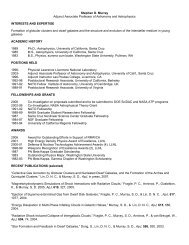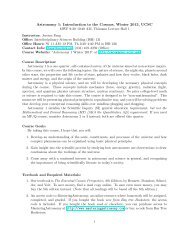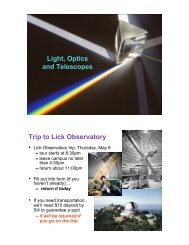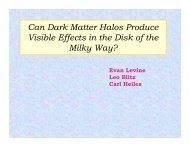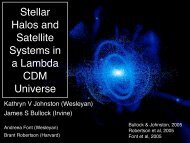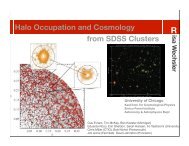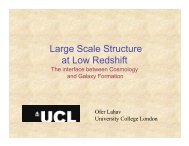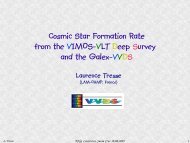Frank van den Bosch
Frank van den Bosch
Frank van den Bosch
Create successful ePaper yourself
Turn your PDF publications into a flip-book with our unique Google optimized e-Paper software.
The Galaxy−Dark Matter Connection<br />
<strong>Frank</strong> C. <strong>van</strong> <strong>den</strong> <strong>Bosch</strong> (ETH)<br />
Xiaohu Yang & Houjun Mo (UMass)
Halo Occupation Modelling<br />
• PARADIGM: Galaxies live in extended Cold Dark Matter Haloes.<br />
• Dark Matter Haloes are a biased tracer of DM mass distribution.<br />
• Halo bias b(M) is cosmology depen<strong>den</strong>t and follows from EPS and/or<br />
• N -body simulations.<br />
• It allows a computation of halo-halo correlation function ξhh(r|M)<br />
• Halo Occupation Models link ξhh(r|M) to ξgg(r) by modelling the halo<br />
• occupation distribution P (N|M), which describes the galaxy bias.<br />
• This yields interesting constraints on 〈Ngal〉(M) and on cosmology<br />
(e.g., Seljak 2000; Scoccimarro et al. 2001; Berlind & Weinberg 2002; Magiocchetti & Porciani 2003;<br />
Abazajian et al. 2004; Collister & Lahav 2004; Zehavi et al. 2004; Zheng et al. 2005)<br />
• However, galaxy bias bgal = bgal(L, type, ...).<br />
• To model bgal(L) we introduce the Conditional Luminosity Function (CLF)<br />
• Φ(L|M) which describes average number of galaxies of luminosity L in<br />
• a halo of mass M .
The Conditional Luminosity Function<br />
CLF is direct link between galaxy LF, Φ(L) and halo mass function, n(M):<br />
Φ(L) = ∞<br />
0<br />
Φ(L|M) n(M) dM<br />
The CLF contains a lot of important information, such as:<br />
• halo occupation numbers as function of luminosity:<br />
NM (L > L1) = ∞<br />
L1<br />
• The average relation between light and mass:<br />
〈L〉(M) = ∞<br />
0<br />
Φ(L|M) dL<br />
Φ(L|M) L dL<br />
• Galaxy clustering properties as function of luminosity:<br />
b(L) = 1<br />
Φ(L)<br />
ξgg(r|L) = b 2 (L) ξdm(r)<br />
∞<br />
0<br />
Φ(L|M) b(M) n(M) dM<br />
CLF is ideal statistical ‘tool’ to investigate Galaxy-Dark Matter Connection
Luminosity & Correlation Functions<br />
ccccc • 2dFGRS: More luminous galaxies are more strongly clustered.<br />
ccccc • c ΛCDM: More massive haloes are more strongly clustered.<br />
More luminous galaxies reside in more massive haloes<br />
We assume that the CLF has a Schechter-form, and constrain Φ(L|M)<br />
using the Φ(L) and r0(L) shown above.
The Relation between Light & Mass<br />
→sam<br />
vdB, Yang, Mo & Norberg, 2005, MNRAS, 356, 1233
HODs from Galaxy Groups<br />
In addition to using clustering data, Halo Occupation Statistics can also be<br />
obtained directly from galaxy groups<br />
Potential Problems: interlopers, (in)completeness, group mass estimates<br />
We have developed a new, iterative group finder, using an adaptive filter<br />
modeled after halo virial properties Yang, Mo, vdB, Jing 2005, MNRAS, 356, 1293<br />
• Using detailed Mock Galaxy Redshift Surveys group finder has been<br />
optimized to associate galaxies that belong to same dark matter halo.<br />
• Significantly fewer interlopers than with standard (FOF-based) group<br />
finders<br />
• Average completeness of individual groups larger than 90 percent.<br />
• The halo masses are estimated from group luminosities. More accurate<br />
than using velocity dispersion, especially for low mass groups.<br />
• Group finder can also detect “groups” with single member<br />
⇒ Large dynamic range in halo masses (11.5 < ∼ log[M] < ∼ 15).<br />
Group finder has been applied to both 2dFGRS (completed survey) and SDSS<br />
(NYU-VAGC; Blanton et al. 2005)
Galaxy Ecology<br />
Many studies have investigated the relation between various galaxy<br />
properties (morphology/SFR/colour) and environment<br />
(e.g., Oemler 1974; Dressler 1980; Postman & Geller 1984; Dominguez et al. 2002; Kauffmann et<br />
al. 2004; Balogh et al. 2004; Goto et al. 2003; Gomez et al. 2003; Hogg et al. 2004; Tanaka et al. 2004)<br />
Environment estimated using galaxy over<strong>den</strong>sity (projected) to nth nearest<br />
neighbour, Σn or using fixed, metric aperture, ΣR.<br />
• Fraction of early types increases with <strong>den</strong>sity<br />
• There is a characteristic <strong>den</strong>sity (∼ group-scale) below which<br />
environment depen<strong>den</strong>ce <strong>van</strong>ishes<br />
• Groups and Clusters also reveal radial depen<strong>den</strong>ce: late type fraction<br />
increases with radius<br />
• No radial depen<strong>den</strong>ce in groups with M < ∼ 1013.5 h −1 M⊙<br />
Danger: Physical meaning of Σn and ΣR depends on environment.<br />
Physically more meaningful to investigate halo mass depen<strong>den</strong>ce of galaxy<br />
properties. This requires galaxy group catalogues.<br />
Important: Separate luminosity depen<strong>den</strong>ce from halo mass depen<strong>den</strong>ce.
Defining Galaxy Types<br />
Data from NYU-VAGC (Blanton et al. 2005): SSFRs from Kauffmann et al. (2003) and Brinchmann et al. (2004)
Halo Mass Depen<strong>den</strong>ce<br />
The fractions of early and late type galaxies depend strongly on halo mass.<br />
At fixed halo mass, there is virtually no luminosity depen<strong>den</strong>ce.<br />
The mass depen<strong>den</strong>ce is smooth: there is no characteristic mass scale; i.e.,<br />
no indication that something special happens at the group or cluster scales.<br />
The intermediate type fraction is indepen<strong>den</strong>t of luminosity and mass.<br />
(Weinmann, vdB, Yang & Mo, 2005)
Depen<strong>den</strong>ce on Group-centric Radius<br />
As noticed before, the late type fraction of satellites increases with radius.<br />
This trend is indepen<strong>den</strong>t of halo mass!<br />
Inconsistent with previous studies, but these included central galaxies.<br />
Our results rule out group- and cluster-specific processes such as<br />
ram-pressure stripping and harassment: nature rather than nurture!<br />
(Weinmann, vdB, Yang & Mo, 2005)
Galactic Conformity<br />
Satellite galaxies ‘adjust’ themselves to properties of their central galaxy:<br />
late type ‘centrals’ have preferentially late type satellites, and vice versa.<br />
This has been noticed before based on small samples of loose groups<br />
(Wirth 1983; Ramella et al. 1987; Osmond & Ponmon 2004).<br />
Our results indicate that this Galactic Conformity is present over large<br />
ranges in luminosity and halo mass. (Weinmann, vdB, Yang & Mo, 2005)
Conclusions<br />
• CLF is a powerful statistical tool. It is strongly constrained by Φ(L)<br />
and r0(L) (Yang, Mo & vdB 2003)<br />
• CLF yields mass-to-light ratios 〈M/L〉(M) and galaxy bias as<br />
function of luminosity, type, etc (vdB, Yang & Mo 2003)<br />
• There is characteristic scale in galaxy formation at ∼ 10 11 M⊙<br />
(vdB, Yang, Mo & Norberg 2005)<br />
• CLF ideal to construct mock galaxy redshift surveys and to study large<br />
scale structure (Yang, Mo, Jing, vdB & Chu 2004)<br />
• Galaxy properties scale smoothly with halo mass. There is no<br />
indication for a specific transition at either group or cluster scale.<br />
• Late type fractions increase with halo-centric radius, indepen<strong>den</strong>t of<br />
halo mass. This rules out ram-pressure stripping and harassment as<br />
physical causes, and favors a ‘nature’ scenario instead.<br />
• Satellite galaxies ‘adjust’ their properties to those of their central<br />
galaxy: Galactic Conformity (Weinmann, vdB, Yang & Mo 2005)




